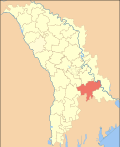- Chițcani
-
Chiţcani (Romanian: Kitskany; Russian: Кицканы) is a commune in Căuşeni district, Moldova. It consists of the village Chiţcani and two small villages (hamlets), Mereneşti and Zahorna. Chiţcani is situated to the south-east of the city of Tighina (Bender). The locality, although situated on the right (western) bank of the river Dniester, is under the control of the breakaway Transnistrian authorities. On the opposite side of the river lies the city of Tiraspol.
Chiţcani is one of the oldest recorded villages in Moldova, its history dating back to 1367. The name of the village means "shrews" in Romanian language.
The village is also well-known as the home of the Noul Neamţ Monastery. The monastery was closed when Moldova was under the Soviet Union. It was then used as a hospital, a storehouse, then as a makeshift museum.[1][2]
Official data for the present population of the commune are not available. Estimates appreciate the current population at ca. 9,000 people, of which ca. 4,800 ethnic Russians, ca. 3,100 ethnic Moldovans (Romanians), ca. 900 ethnic Ukrainians, and ca. 200 other. This data, however, is not reliable.
At the 1930 Romanian Census, there were 4,744 inhabitants in Chiţcani, including the 2,456 Romanians, 2,146 Russians, 71 Ruthenians and Ukrainians, 35 Jews, 16 Gypsies, 7 Poles, 3 Bulgarians, 2 Gagauzians, and 8 unclear. 2,426 people named Romanian as native language, 2,245 named Russian, 35 named Yiddish, 27 named Ukrainian, 5 named Gypsy, 3 named Bulgarian, 2 named Turkish, and 1 non-declared.
At the time, the village was part of Plasa Căuşani of Tighina County.
During the 1992 War of Transnistria, especially during the months of June and July, Chiţcani was the science of several gun-battles between the Moldovan police and army on one side, and Transnistrian separatists and Russia's 14th Army on the other side. After the Moldovans have retreated when the war ended, the village was the scene of human rights abuses perpetrated by the Transnistrians, who took revenge on the locals that supported the Moldovan police. According to the Helsinki Committee for Human Rights in Moldova, there were some alleged 20 killings between 1996 and 2000. Moldovan authorities have stated that they have no access to the village to investigate these cases, while Transnistrian authorities denied the allegations and refused to investigate.[3][4]
References
Coordinates: 46°47′N 29°37′E / 46.783°N 29.617°E
Cities Communes Baccealia | Baimaclia | Chircăiești | Chircăieştii Noi | Chiţcani | Ciufleşti | Cîrnăţeni | Cîrnăţenii Noi | Copanca | Coşcalia | Cremenciug | Fîrlădeni | Gîsca | Grădiniţa | Grigorievca | Hagimus | Opaci | Pervomaisc | Plop-Ştiubei | Săiţi | Sălcuţa | Taraclia | Tănătari | Tănătarii Noi | Tocuz | Ucrainca | Ursoaia | Zaim
Villages
of sub-city or
sub-commune levelCăinari, loc.st.cf | Tricolici | Surchiceni | Baurci | Mereneşti | Zahorna | Sălcuţa Nouă | Florica | Plop | Fîrlădenii Noi | Leuntea | Valea Verde | Constantinovca | Ştefăneşti | Ursoaia Nouă | Zviozdocica | Marianca de Sus | Zaim, loc. st. c. f.
Geography of the Transnistrian conflict Moldovan control Transnistrian control Northern security zoneSouthern security zoneNorthern security zoneSouthern security zone1 belongs to Dubăsari district; 2 belongs to Anenii Noi district; 3 belongs to Căuşeni district; 4 also known as Bender or Tighina; belongs to Municipality of Bender; 5 belongs to the territorial unit TransnistriaCategories:- Communes of Căuşeni district
- Populated places under Transnistrian control
Wikimedia Foundation. 2010.

